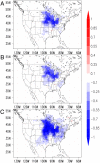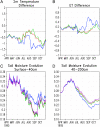Direct climate effects of perennial bioenergy crops in the United States
- PMID: 21368189
- PMCID: PMC3060251
- DOI: 10.1073/pnas.1008779108
Direct climate effects of perennial bioenergy crops in the United States
Abstract
Biomass-derived energy offers the potential to increase energy security while mitigating anthropogenic climate change, but a successful path toward increased production requires a thorough accounting of costs and benefits. Until recently, the efficacy of biomass-derived energy has focused primarily on biogeochemical consequences. Here we show that the biogeophysical effects that result from hypothetical conversion of annual to perennial bioenergy crops across the central United States impart a significant local to regional cooling with considerable implications for the reservoir of stored soil water. This cooling effect is related mainly to local increases in transpiration, but also to higher albedo. The reduction in radiative forcing from albedo alone is equivalent to a carbon emissions reduction of , which is six times larger than the annual biogeochemical effects that arise from offsetting fossil fuel use. Thus, in the near-term, the biogeophysical effects are an important aspect of climate impacts of biofuels, even at the global scale. Locally, the simulated cooling is sufficiently large to partially offset projected warming due to increasing greenhouse gases over the next few decades. These results demonstrate that a thorough evaluation of costs and benefits of bioenergy-related land-use change must include potential impacts on the surface energy and water balance to comprehensively address important concerns for local, regional, and global climate change.
Conflict of interest statement
The authors declare no conflict of interest.
Figures



Similar articles
-
Climate change mitigation potentials of biofuels produced from perennial crops and natural regrowth on abandoned and degraded cropland in Nordic countries.J Environ Manage. 2023 Jan 1;325(Pt A):116474. doi: 10.1016/j.jenvman.2022.116474. Epub 2022 Oct 21. J Environ Manage. 2023. PMID: 36274301
-
Consensus, uncertainties and challenges for perennial bioenergy crops and land use.Glob Change Biol Bioenergy. 2018 Mar;10(3):150-164. doi: 10.1111/gcbb.12488. Epub 2017 Nov 27. Glob Change Biol Bioenergy. 2018. PMID: 29497458 Free PMC article. Review.
-
Landscape patterns of bioenergy in a changing climate: implications for crop allocation and land-use competition.Ecol Appl. 2016 Mar;26(2):515-29. doi: 10.1890/15-0545. Ecol Appl. 2016. PMID: 27209792
-
Implications for the hydrologic cycle under climate change due to the expansion of bioenergy crops in the Midwestern United States.Proc Natl Acad Sci U S A. 2011 Sep 13;108(37):15085-90. doi: 10.1073/pnas.1107177108. Epub 2011 Aug 29. Proc Natl Acad Sci U S A. 2011. PMID: 21876137 Free PMC article.
-
Potential of global croplands and bioenergy crops for climate change mitigation through deployment for enhanced weathering.Biol Lett. 2017 Apr;13(4):20160714. doi: 10.1098/rsbl.2016.0714. Biol Lett. 2017. PMID: 28381630 Free PMC article. Review.
Cited by
-
Land-use change and greenhouse gas emissions from corn and cellulosic ethanol.Biotechnol Biofuels. 2013 Apr 10;6(1):51. doi: 10.1186/1754-6834-6-51. Biotechnol Biofuels. 2013. PMID: 23575438 Free PMC article.
-
The mark of vegetation change on Earth's surface energy balance.Nat Commun. 2018 Feb 20;9(1):679. doi: 10.1038/s41467-017-02810-8. Nat Commun. 2018. PMID: 29463795 Free PMC article.
-
The influence of biomass energy consumption on CO2 emissions: a wavelet coherence approach.Environ Sci Pollut Res Int. 2016 Oct;23(19):19043-61. doi: 10.1007/s11356-016-7094-2. Epub 2016 Jun 23. Environ Sci Pollut Res Int. 2016. PMID: 27335019
-
The Sensitivity of Land-Atmosphere Coupling to Modern Agriculture in the Northern Midlatitudes.J Clim. 2019 Jan 15;32(2):465-484. doi: 10.1175/JCLI-D-17-0799.1. Epub 2018 Dec 26. J Clim. 2019. PMID: 32699488 Free PMC article.
-
Representing agriculture in Earth System Models: approaches and priorities for development.J Adv Model Earth Syst. 2017 Sep;9(5):2230-2265. doi: 10.1002/2016MS000749. Epub 2017 Aug 31. J Adv Model Earth Syst. 2017. PMID: 30574266 Free PMC article.
References
-
- Sustainable Bioenergy: A Framework for Decision Makers. Geneva: United Nations; 2007. Available at http://esa.un.org/un-energy/pdf/susdev.Biofuels.FAO.pdf.
-
- Fargione J, Jason H, Tilman D, Polasky S, Hawthorne P. Land clearing and the biofuel carbon debt. Science. 2008;319:1235–1238. - PubMed
-
- Martindale W, Trewavas A. Fuelling the 9 billion. Nature Biotechnol. 2008;26:1068–1070. - PubMed
-
- Searchinger T, et al. Use of US croplands for biofuels increases greenhouse gases through emissions from land-use change. Science. 2008;319:1238–1240. - PubMed
Publication types
MeSH terms
Substances
LinkOut - more resources
Full Text Sources

